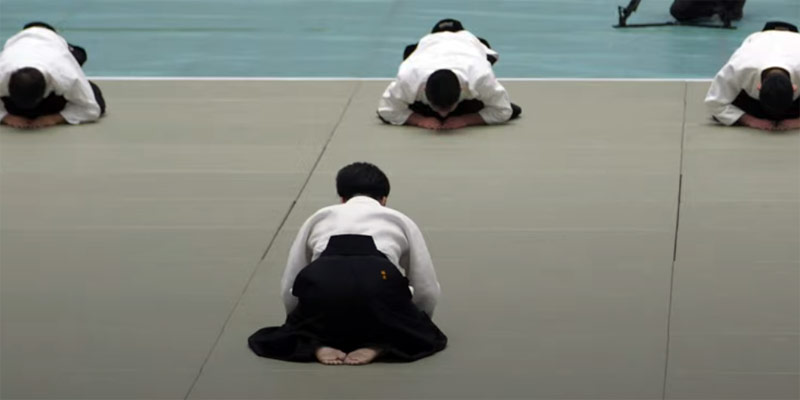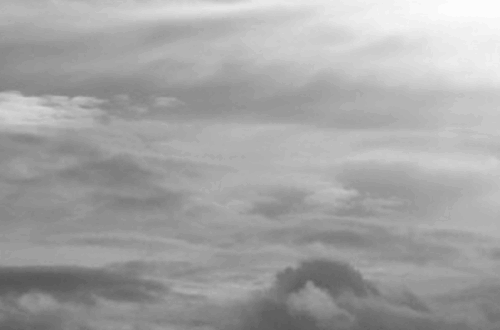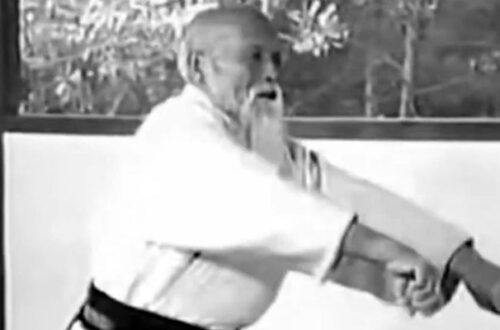
Seiza and Zarei: Embodying Japanese Cultural Values in Aikido
Seiza 正座 and Zarei 座礼, two fundamental practices in Aikido, embody profound cultural and philosophical significance rooted in Japanese tradition.
Sei means correct or proper, and Za means sit, so Seiza literally means “correct sitting.” It holds deep historical roots in Japanese culture, particularly within martial arts and ceremonial contexts. In Aikido, practitioners assume the Seiza position by kneeling with their buttocks resting on their heels, both feet flat on the mat, and the big toes may slightly overlap, maintaining an upright posture with a straight spine. Hands rest on the thighs with palms facing down. Taking slow, deep breaths, practitioners relax and cultivate a sense of openness and receptivity.
There are various theories about the origin of seiza in Japan, but no definitive answer exists. Some believe it was introduced from China, while many others believe it was originally used by commoners when bowing deeply to nobles or by retainers to their lords, as a demonstration of respect and humility. Another suggestion is that seiza was intended to make retainers less mobile when facing their lords or shogun, thereby preventing sudden attacks on them. Regardless of its origin, seiza was widely adopted by samurai society during the Edo 江戸 period. It was later embraced by practitioners of the Sado 茶道 (tea ceremony) and Nohgaku 能楽 (a traditional form of Japanese theater), marking the transition from the traditional Anza 安座 (cross-legged sitting) to Seiza 正座. After the Meiji Restoration 明治維新, seiza was further adopted to emphasize the contrast with Western countries and strengthen Japanese identity.

Nohgaku performers in seiza
Rei refers to the social norms and rules that should be observed to maintain social order and smooth human relationships. These include etiquette, manners, and systems. Rei can also refer to bowing in Japanese culture. Zarei, therefore, refers to bowing in a seiza position. To perform zarei, practitioners slowly slide their hands down their thighs and place them on the floor in front of their knees, forming a slight triangle shape with their fingers together. Then, they lower their upper body forward from the hips while maintaining a straight spine and avoiding rounding their shoulders until their forehead comes close to the floor. Traditionally, when the body comes parallel to the floor and the forehead is about 30cm from the floor, it is called a Futsurei 普通礼 (common bow). If the forehead goes further down, almost touching the floor, it is called a Saikorei 最敬礼 (deepest respectful bow). Practitioners pause briefly (about 3 seconds) in the bowing position before slowly returning to seiza, with the entire process taking about 10 seconds. Details and timing can vary in different practices. Zarei serves as a gesture of respect and gratitude.

“Everything begins and ends with bowing”
During the Sengoku 戦国 period, the samurai class developed and refined various forms of bowing, including zarei, as a means of demonstrating respect and loyalty. Zarei was also incorporated into Sado as a crucial element. Participants bow to each other in seiza to express mutual respect and appreciation. In Aikido practice, as well as many other Japanese martial arts, zarei is performed to show respect to instructors, training partners, and the dojo. There is a Japanese saying, “Rei ni hajimari, rei ni owaru 礼に始まり礼に終わる” which can be translated as “Everything begins and ends with bowing.” In Japanese culture, this expression is highly valued, not just practiced in the dojo, but in everyday life as well.
Seiza and Zarei are more than mere physical rituals; they encapsulate deeper values and principles integral to Japanese culture and philosophy. Through these practices, practitioners cultivate humility, respect, and mindfulness, fostering an environment of harmony and mutual respect both on and off the mat. By honoring these traditions, Aikido practitioners uphold the essence of the martial art and embody its core principles in their daily lives.
Suggested reading: The Art of Shikko and Suwari Waza
Author’s Note: We appreciate your readership! This article serves as a preliminary introduction to the subject matter. While we aim for accuracy, we cannot guarantee the content’s precision and it may contain elements of speculation. We strongly advise you to pursue additional research if this topic piques your interest. Begin your AikidoDiscovery adventure! 🙂





One Comment
Eduardo
Es muy importante difundir esto ,por qué la mayoría de las cosas que hacen los japoneses sobre todo en artes marciales están lleno de profundidad ,y sobre todo basada en la práctica constante ..